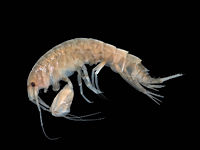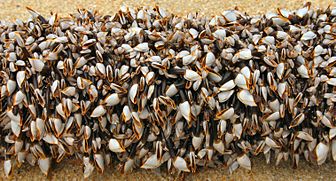Clinfowiki
The Crustaceans Portal Crustaceans (from Latin meaning: "those with shells" or "crusted ones") are invertebrate animals that constitute one group of arthropods that are a part of the subphylum Crustacea (/krəˈsteɪʃə/), a large, diverse group of mainly aquatic arthropods including decapods (shrimps, prawns, crabs, lobsters and crayfish), seed shrimp, branchiopods, fish lice, krill, remipedes, isopods, barnacles, copepods, opossum shrimps, amphipods and mantis shrimp. The crustacean group can be treated as a subphylum under the clade Mandibulata. It is now well accepted that the hexapods (insects and entognathans) emerged deep in the Crustacean group, with the completed pan-group referred to as Pancrustacea. The three classes Cephalocarida, Branchiopoda and Remipedia are more closely related to the hexapods than they are to any of the other crustaceans (oligostracans and multicrustaceans). The 67,000 described species range in size from Stygotantulus stocki at 0.1 mm (0.004 in), to the Japanese spider crab with a leg span of up to 3.8 m (12.5 ft) and a mass of 20 kg (44 lb). Like other arthropods, crustaceans have an exoskeleton, which they moult to grow. They are distinguished from other groups of arthropods, such as insects, myriapods and chelicerates, by the possession of biramous (two-parted) limbs, and by their larval forms, such as the nauplius stage of branchiopods and copepods. Most crustaceans are free-living aquatic animals, but some are terrestrial (e.g. woodlice, sandhoppers), some are parasitic (e.g. Rhizocephala, fish lice, tongue worms) and some are sessile (e.g. barnacles). The group has an extensive fossil record, reaching back to the Cambrian. More than 7.9 million tons of crustaceans per year are harvested by fishery or farming for human consumption, consisting mostly of shrimp and prawns. Krill and copepods are not as widely fished, but may be the animals with the greatest biomass on the planet, and form a vital part of the food chain. The scientific study of crustaceans is known as carcinology (alternatively, malacostracology, crustaceology or crustalogy), and a scientist who works in carcinology is a carcinologist. (Full article...) Selected article
Krill is a shrimp-like marine invertebrate animal. These small crustaceans are important organisms of the zooplankton, particularly as food for baleen whales, manta rays, whale sharks, crabeater seals, other seals, and a few seabird species that feed almost exclusively on them. Krill occur in all oceans of the world. They are considered an important trophic connection – near the bottom of the food chain – because they feed on phytoplankton and to a lesser extent zooplankton, converting these into a form suitable for many larger animals for whom krill makes up the largest part of their diet. In the Southern Ocean, one species, the Antarctic krill, Euphausia superba, makes up an estimated biomass of over 500 million tonnes, roughly twice that of humans. Of this, over half is eaten by whales, seals, penguins, squid and fish each year, and is replaced by growth and reproduction. Most krill species display large daily vertical migrations, thus providing food for predators near the surface at night and in deeper waters during the day.
Did you know?
Selected biography
Pierre André Latreille (November 20, 1762 – February 6, 1833) was a French zoologist, specialising in arthropods. Latreille was born illegitimately on November 29, 1762 in the town of Brive, then in the province of Limousin. Having trained as a Roman Catholic priest before the French Revolution, Latreille was imprisoned after the Civil Constitution of the Clergy, and only regained his freedom after recognising a rare species he found in the prison, Necrobia ruficollis.
He published his first important work in 1796 (Précis des caractères génériques des insectes), and was eventually employed by the Muséum National d'Histoire Naturelle. His foresighted work on arthropod systematics and taxonomy, using all available characters and rejecting anthropocentrism and teleology, gained him respect and accolades. He was considered the foremost entomologist of his time, and was described by one of his pupils as "the prince of entomologists". He helped found the Société entomologique de France, acting as honorary president, and was honoured by having dozens of species and genera named after him. Selected image Goose barnacles (order Pedunculata), such as these Lepas anatifera, are filter-feeding crustaceans that live attached to hard surfaces of rocks and flotsam in the intertidal zone. General imagesThe following are images from various crustacean-related articles on Wikipedia.
Crustacean lists
SubcategoriesRelated portalsWikiProjectsAssociated WikimediaThe following Wikimedia Foundation sister projects provide more on this subject:
Discover Wikipedia using portals
Purge server cache
|




































































